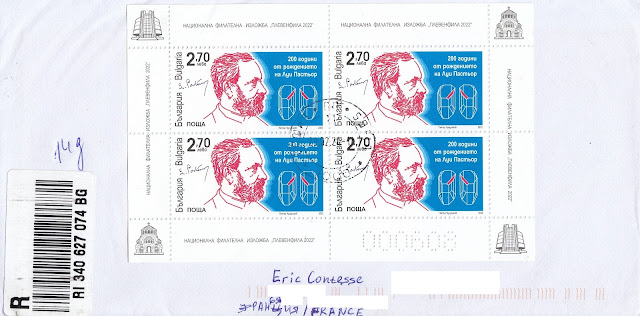Bloc-feuillet "Louis Pasteur (1822-1895) - Exposition PlevenFila 2022" sur lettre de Bulgarie
Pionnier de la microbiologie, le scientifique, chimiste et physicien de formation français Louis Pasteur (1822-1895) connut, de son vivant même, une grande
notoriété pour avoir mis au point, entre autres, un vaccin contre la rage.
Plus
largement, ses découvertes ont bouleversé les conceptions de la
pathologie infectieuse, influencé la chimie biologique et créé de
nouvelles méthodes industrielles, faisant de ce travailleur infatigable
l'une des figures mondiales les plus célèbres de la science.
Comme
d'autres administrations postales (Roumanie, Vietnam, France, Andorre, Macédoine du Nord, Hongrie, Moldavie, Corée du Sud, Pologne, Kirghizstan), la
poste de Bulgarie a mis en circulation, le 9 décembre 2022, un
timbre (2,70 leva) à l'occasion du 200ème anniversaire de la naissance de
Louis Pasteur.
Ce timbre (conception : Petar Chuchuligov) a été imprimé en feuille de 40 timbres ainsi que dans un bloc-feuillet composé de 4 timbres.
A pioneer in microbiology, the French scientist, chemist and physicist Louis Pasteur (1822-1895) known a great notoriety during his lifetime for having developed, among other things, a rabies vaccine.
More broadly, his discoveries overturned conceptions of infectious pathology, influenced biological chemistry and created new industrial methods, making this tireless worker one of the world's most famous figures in science.
Like other postal administrations (Romania, Vietnam, France, Andorra, North Macedonia, Hungary, Moldova, South Korea, Poland, Kyrgyzstan), the Post of Bulgaria put into circulation, on December 9, 2022, a stamp (2,70 leva) on the occasion of the 200th anniversary of the birth of Louis Pasteur.
This stamp (design: Petar Chuchuligov) was printed in a sheet of 40 stamps as well as in a souvenir sheet consisting of 4 stamps.
Ce bloc-feuillet (tirage : 1400) a été utilisé sur la jolie lettre ci-dessus envoyée en recommandé le 29 février 2024 depuis Sofia, la capitale. Merci beaucoup Borislav !
Ce timbre comporte un portrait de Pasteur, sa signature ainsi que deux formes de cristaux d'acide tartrique, ayant permis au scientifique de découvrir la dissymétrie moléculaire, au début de sa carrière (en 1848). Ces mêmes cristaux figuraient sur le timbre français émis en 1995 pour le centenaire de la mort de Louis Pasteur.
Ce bloc-feuillet bulgare a été émis dans le cadre de l'exposition philatélique "PlevenFila 2022" organisée du 9 au 11 décembre 2022 dans la ville de Pleven (nord du pays), en collaboration avec le musée historique régional et l'union des philatélistes bulgares.
Deux édifices emblématiques de cette ville de Pleven sont représentés dans les coins de ce bloc-feuillet : la chapelle mausolée Saint-Georges-le-Conquérant (1907), dédiée aux soldats russes et roumains tombés pour la libération de la Bulgarie lors du siège de Pleven en 1877, et le musée "Panorama de Pleven", inauguré en 1977 pour commémorer les 100 ans de ce siège de Pleven.
Cette bataille, qui fut un épisode majeur de la guerre russo-turque de 1877-1878, ouvrit la voie à la libération de la Bulgarie du joug ottoman.
This souvenir sheet (print run: 1,400) was used on the pretty cover above sent by registered mail on February 29, 2024 from Sofia, the capital. Thank you very much Borislav!
This stamp features a portrait of Pasteur, his signature as well as two forms of tartaric acid crystals, having allowed the scientist to discover molecular asymmetry at the start of his career (in 1848). These same crystals appeared on the French stamp issued in 1995 for the centenary of the death of Louis Pasteur.
This Bulgarian souvenir sheet was issued as part of the philatelic exhibition "PlevenFila 2022" organized from December 9 to 11, 2022 in the city of Pleven (north of the country), in collaboration with the regional historical museum and the union of Bulgarian philatelists.
Two emblematic buildings of this town of Pleven are represented in the corners of this souvenir sheet: the St George the Conqueror Chapel Mausoleum (1907), dedicated to the Russian and Romanian soldiers who fell for the liberation of Bulgaria during the Siege of Pleven in 1877, and the "Pleven Panorama" museum, inaugurated in 1977 to commemorate the 100 years of this Siege of Pleven.
This battle, which was a major episode in the Russian-Turkish War of 1877-1878, opened the way for the liberation of Bulgaria from the Ottoman yoke.

Aucun commentaire:
Enregistrer un commentaire